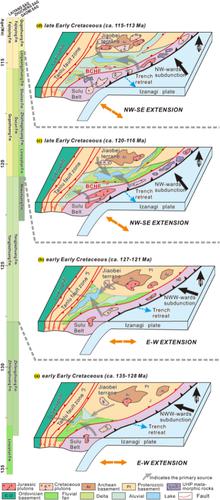当前位置:
X-MOL 学术
›
Basin Res.
›
论文详情
Our official English website, www.x-mol.net, welcomes your
feedback! (Note: you will need to create a separate account there.)
Northward expansion of the Jiaolai Basin during the Early Cretaceous: Insights from source-to-sink reconstruction
Basin Research ( IF 2.8 ) Pub Date : 2024-02-17 , DOI: 10.1111/bre.12856 Bo Zhang 1 , Shaofeng Liu 1, 2 , Chengfa Lin 1 , Pengfei Ma 3
Basin Research ( IF 2.8 ) Pub Date : 2024-02-17 , DOI: 10.1111/bre.12856 Bo Zhang 1 , Shaofeng Liu 1, 2 , Chengfa Lin 1 , Pengfei Ma 3
Affiliation

|
The Jiaolai Basin, situated in the northern Sulu orogenic belt along East Aisa continental margin, preserves evidence of the extensional events in East Asia and the post-orogenic evolution of the Sulu orogenic belt during the Cretaceous period. In this study, multiple provenance analyses were employed to reconstruct the source-to-sink system of the Laiyang Group within the Jiaolai Basin. These studies reveal a history of northward expansion dictated by two significant rift events. During the early Early Cretaceous period (ca. 135–121 Ma), the Zhucheng and Gaomi sags in southern region developed initially. Subsequently, in the late Early Cretaceous period (ca. 120–113 Ma), the Laiyang sag in northern region emerged. Furthermore, these sags were fed by independent source-to-sink systems in their early stages but eventually shared a similar source-to-sink system towards the end of the Laiyang Group deposition (ca. 113 Ma). The provenance analysis results indicate that ca. 121 Ma, ultrahigh-pressure rocks in the northern segment of the Sulu orogenic belt experienced rapid exhumation, while those in the southern segment might have remained concealed until ca. 113 Ma. The two rift events in East Asia, coupled with the alteration in the direction and magnitude of extension documented in the Jiaolai Basin, suggests that trench retreat and the change in subduction direction from E–W to NW–SE of the Izanagi plate played a principal role in driving the extensional events in East Asia during the Early Cretaceous. Our findings imply that the change in Izanagi subduction direction may have occurred ca. 121 Ma.
中文翻译:

早白垩世胶莱盆地向北扩张:源汇重建的启示
胶莱盆地位于东亚大陆边缘苏鲁造山带北部,保存有白垩纪东亚伸展事件和苏鲁造山带造山后演化的证据。本研究采用多物源分析方法重建胶莱盆地莱阳群的源汇系统。这些研究揭示了由两次重大裂谷事件决定的向北扩张的历史。早白垩世早期(约135~121Ma),南部诸城、高密凹陷初步发育。随后,早白垩世晚期(约120~113Ma),北部地区莱阳凹陷出现。此外,这些凹陷在早期阶段由独立的源-汇系统供给,但最终在莱阳群沉积末期(约113 Ma)共享一个类似的源-汇系统。来源分析结果表明大约。 121 Ma,苏鲁造山带北段的超高压岩石经历了快速折返,而南段的超高压岩石可能一直被隐藏到大约121 Ma。 113马。东亚的两次裂谷事件,加上胶莱盆地记录的伸展方向和幅度的变化,表明海沟后退和伊诺岐板块从东西向到西北-东南俯冲方向的变化起到了主要作用。早白垩世期间东亚伸展事件的驱动作用。我们的发现意味着伊邪那岐俯冲方向的变化可能发生在大约。 121马。
更新日期:2024-02-17
中文翻译:

早白垩世胶莱盆地向北扩张:源汇重建的启示
胶莱盆地位于东亚大陆边缘苏鲁造山带北部,保存有白垩纪东亚伸展事件和苏鲁造山带造山后演化的证据。本研究采用多物源分析方法重建胶莱盆地莱阳群的源汇系统。这些研究揭示了由两次重大裂谷事件决定的向北扩张的历史。早白垩世早期(约135~121Ma),南部诸城、高密凹陷初步发育。随后,早白垩世晚期(约120~113Ma),北部地区莱阳凹陷出现。此外,这些凹陷在早期阶段由独立的源-汇系统供给,但最终在莱阳群沉积末期(约113 Ma)共享一个类似的源-汇系统。来源分析结果表明大约。 121 Ma,苏鲁造山带北段的超高压岩石经历了快速折返,而南段的超高压岩石可能一直被隐藏到大约121 Ma。 113马。东亚的两次裂谷事件,加上胶莱盆地记录的伸展方向和幅度的变化,表明海沟后退和伊诺岐板块从东西向到西北-东南俯冲方向的变化起到了主要作用。早白垩世期间东亚伸展事件的驱动作用。我们的发现意味着伊邪那岐俯冲方向的变化可能发生在大约。 121马。


















































 京公网安备 11010802027423号
京公网安备 11010802027423号